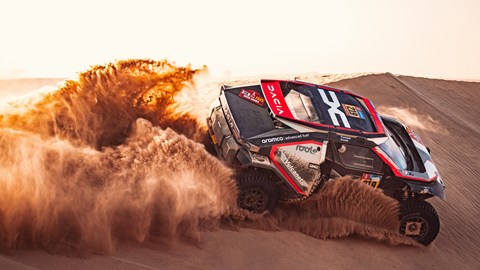► Factory Ford team secures third place
► Al-Rajhi wins on home soil
► One of the closest finishes in Dakar history
Ford has scored a podium finish on its Dakar Rally debut. Mattias Ekstrom finished third in the M-Sport-run, V8-powered Ford Raptor, just 20 minutes behind the winner in one of the closest finishes in Dakar history.
The Ford team looked like it might miss securing a significant result when team leader Carlos Sainz was forced out after rolling his car during the 48-hour ‘Chrono’ stage in the first week of the event. But Ekstrom strung together a consistent campaign, only failing to post a top ten stage time on three occasions, and winning Stage 11.
Sainz was the only Ford entry to retire. Mitchell Guthrie finished a highly creditable fifth on his debut in the Ultimate car category, an hour down on the winner. Nani Roma endured a torrid event and, despite securing Ford’s first win on Stage 10, he finished all the way down in 43rd place.
Local hero Yazeed Al-Rajhi took his first Dakar Rally win by less than four minutes in his privateer Overdrive Racing Toyota Hilux – a remarkably tight finish after 8,000km of racing. Al-Rajhi becomes the first Saudi Dakar winner, at his 11th attempt. He and co-driver Timo Gottschalk had held second place throughout much of the rally, always within a few of minutes of erstwhile leader Henk Lategan – contesting his fourth Dakar.
The pair swapped positions during the latter part of week two and went into the final day separated by just over six minutes. But, with 62km of competitive running remaining, Lategan didn’t have the time to make up the deficit in his factory-run Toyota.

Dacia missed out on a debut podium finish by three minutes, Nasser Al-Attiyah bringing his Dacia Sandrider home in fourth place. The five-time Dakar winner held that position for most of the rally, always within striking distance of third. But navigation issues on Stage 10 created a deficit he couldn’t overcome.
Al-Attiyah’s teammate Sebastien Loeb, still chasing his first Dakar win after nine goes, crashed out during the first week. Like Sainz, he made it back to base but the FIA scrutineers judged the car was beyond repair and forced Loeb’s retirement. Cristina Gutierrez was always going to play a supporting role in the third Dacia, particularly after she lost a huge amount of time on Stage 2. Her car was used a rolling parts supply for the remainder of the rally, and she crossed the finish in 41st.
The rest of the top ten all finished within three hours of the winner – a notably tight spread. Matthieu Serradori was sixth in an Audi-powered Century, Juan Cruz Yacopini was seventh in his Overdrive-run Hilux, Joao Ferreira in eighth was fastest of the X-Raid Minis, Seth Quintero was ninth in a Toyota Gazoo Racing Hilux, and Brian Baragwanath was tenth in the second factory-run Century.
Among the other categories, Daniel Sanders took his maiden Dakar win in the Rally GP bike class and rookie Edgar Canet won the production-based Rally 2 division, both on factory KTMs.
Martin Macik took his second Truck category win by over two hours having held the lead for the vast majority of the event. He was a remarkable 16th overall in the combined four-wheeler ranking, as well.
Nicolas Cavigliasso took his first win in the Challenger buggy class, a fine start to the World Rally Raid Championship season for the reigning class title holder. American Brock Heger put his considerable desert racing experience to good use, winning the SSV class at the first time of asking.